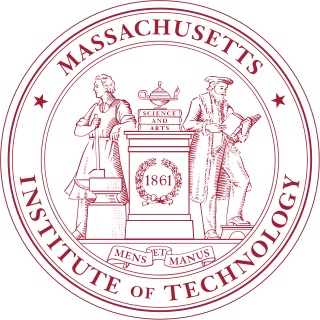
The Massachusetts Institute of Technology (MIT) is a private land-grant research university in Cambridge, Massachusetts. Established in 1861, MIT has played a significant role in the development of many areas of modern technology and science.
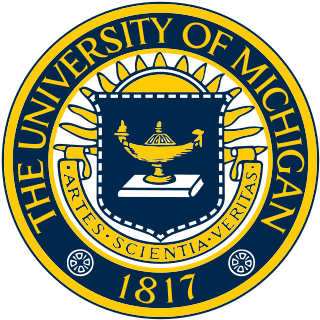
The University of Michigan Library is the academic library system of the University of Michigan. The university's 38 constituent and affiliated libraries together make it the second largest research library by number of volumes in the United States.
The University of California operates the largest academic library system in the world. It manages more than 40.8 million print volumes in 100 libraries on ten campuses. The purpose of these libraries is to assist research and instruction on the University of California campuses. While each campus library is separate, they share facilities for storage, computerized indexing, digital libraries and management.
The Lied Library building is located on the University of Nevada's Las Vegas (UNLV) campus in Paradise, Nevada. At 5 stories high and 302,000 square feet (28,100 m2), it is the largest building on the campus and the Architect of Record was Welles Pugsley Architects. It first opened on January 8, 2001. UNLV Libraries was established in 1957 and include the Lied Library that opened in 2001. Other campus libraries are the Architecture Studies Library, the Health Sciences Library, the Teacher Development & Resources Library, and the UNLV Music Library. UNLV Libraries has a collection of more than one million volumes, access to over 20,000 online and print journals, and more than 2 million additional resources of various media such as microfilm, DVDs, and government publications.
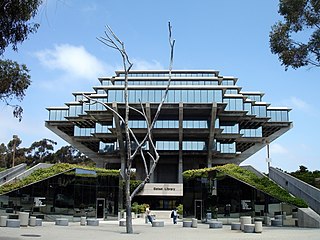
Geisel Library is the main library building of the University of California, San Diego. It is named in honor of Audrey and Theodor Seuss Geisel. Theodor is better known as children's author Dr. Seuss. The building's distinctive architecture, described as occupying "a fascinating nexus between brutalism and futurism", has resulted in its being featured in the UC San Diego logo and becoming the most recognizable building on campus.

Columbia University Libraries is the library system of Columbia University and one of the largest academic library systems in North America. With 15.0 million volumes and over 160,000 journals and serials, as well as extensive electronic resources, manuscripts, rare books, microforms, maps, and graphic and audio-visual materials, it is the fifth-largest academic library in the United States and the largest academic library in the State of New York. Additionally, the closely affiliated Jewish Theological Seminary Library holds over 400,000 volumes, which combined makes the Columbia University Libraries the third-largest academic library, and the second-largest private library in the United States.

The Yale University Library is the library system of Yale University in New Haven, Connecticut. Originating in 1701 with the gift of several dozen books to a new "Collegiate School," the library's collection now contains approximately 14.9 million volumes housed in fifteen university buildings and is the fourth-largest academic library in North America.
The University of British Columbia Library is the library system of the University of British Columbia (UBC). The library is one of the 124 members of the Association of Research Libraries (ARL). In 2017, UBC Library ranked 29th among members of the ARL for the number of volumes in library, making it the third largest Canadian academic library after the University of Toronto and the University of Alberta. However, UBC Library ranked 23rd for the titles held and second in Canada, and had a materials expenditures of $13.8 million, placing it 44th.

The Texas A&M University Libraries support the teaching, research, and outreach missions of Texas A&M University through leadership in acquiring, managing, and delivering information in an environment that fosters learning and inquiry. In particular, Texas A&M is nationally and internationally recognized for many research collections, including:
With the growth of science fiction studies as an academic discipline as well as a popular media genre, a number of libraries, museums, archives, and special collections have been established to collect and organize works of scholarly and historical value in the field.
SIMILE was a joint research project run by the World Wide Web Consortium (W3C), Massachusetts Institute of Technology Libraries and MIT CSAIL and funded by the Andrew W. Mellon Foundation. The project ran from 2003 to August 2008. It focused on developing tools to increase the interoperability of disparate digital collections. Much of SIMILE's technical focus is oriented towards Semantic Web technology and standards such as Resource Description Framework (RDF).
The Hamilton Library at the University of Hawaiʻi at Mānoa is the largest research library in the state of Hawaii. The Library serves as a key resource for the flagship Manoa campus as well as the other University of Hawaii system campuses.

The New York Public Library for the Performing Arts, Dorothy and Lewis B. Cullman Center, at 40 Lincoln Center Plaza, is located in Manhattan, New York City, at the Lincoln Center for the Performing Arts on the Upper West Side, between the Metropolitan Opera House and the Vivian Beaumont Theater. It houses one of the world's largest collections of materials relating to the performing arts. It is one of the four research centers of the New York Public Library's Research library system, and it is also one of the branch libraries.
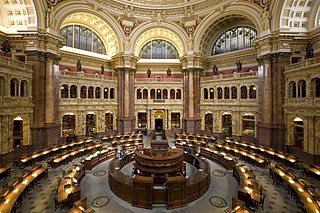
The Library of Congress (LOC) is a research library in Washington, D.C., that serves as the library of the U.S. Congress and the de facto national library of the United States. Founded in 1800, the library is the United States's oldest federal cultural institution. The library is housed in three buildings in the Capitol Hill area of Washington. The Library also maintains a conservation center in Culpeper, Virginia. The library's functions are overseen by the Librarian of Congress, and its buildings are maintained by the Architect of the Capitol. The Library of Congress is one of the largest libraries in the world. Its collections contain approximately 173 million items, and it has more than 3,000 employees. Its "collections are universal, not limited by subject, format, or national boundary, and include research materials from all parts of the world and in more than 470 languages."

Smithsonian Libraries and Archives is an institutional archives and library system comprising 21 branch libraries serving the various Smithsonian Institution museums and research centers. The Libraries and Archives serve Smithsonian Institution staff as well as the scholarly community and general public with information and reference support. Its collections number nearly 3 million volumes including 50,000 rare books and manuscripts.

The William F. Ekstrom Library is the main branch of the University of Louisville Libraries system. Located on the university's Belknap Campus in Louisville, Kentucky, Ekstrom Library contains collections in the humanities, sciences, and social sciences. The University of Louisville Libraries is a member of the Association of Research Libraries (ARL) and, along with Ekstrom, includes libraries for Art, Health Sciences, Law, and Music, as well as the Archives and Special Collections. The University of Louisville Libraries hold approximately 2.2 million print volumes, subscribe to several thousand serials, and provide full-text electronic access to approximately 74,000 journals. Ekstrom is a Federal Depository Library and houses the largest selective government document collection in Kentucky.

The State Library of Massachusetts in Boston, Massachusetts was established in 1826 and "supports the research and information needs of government, libraries, and people through ... services and access to a comprehensive repository of state documents and other historical items." It "opened in 1826 and has been in its present location in the State House since the 1890s." The State Library falls under the administration of the governor.

Princeton University Library is the main library system of Princeton University. With holdings of more than 7 million books, 6 million microforms, and 48,000 linear feet of manuscripts, it is among the largest libraries in the world by number of volumes. The main headquarters of the university system is the Harvey S. Firestone Memorial Library building, named after tire magnate Harvey Firestone. Additionally, Princeton is part of the Research Collections and Preservation Consortium (ReCAP) along with Columbia Libraries, Harvard Library and New York Public Library.
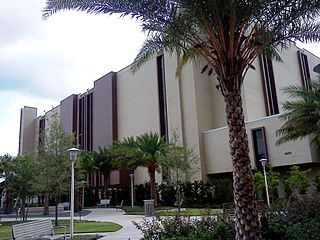
The University of South Florida Tampa Library is the main research library for the University of South Florida. Housing over 1.3 million books, academic journals and electronic resources, including 52,000 e-journal subscriptions, 443,000 e-books, and over 800 databases, the library has more than 2 million visitors each year. The library offers tutoring and writing services, laptops, a career resource center, and course reserves. The facility houses several special and digital collections, including literature, oral histories, photographs, artifacts, and the university archives. The current Dean of USF Libraries is Todd Chavez.

The Harold B. Lee Library (HBLL) is the main academic library of Brigham Young University (BYU) located in Provo, Utah. The library started as a small collection of books in the president's office in 1876 before moving in 1891. The Heber J. Grant Library building was completed in 1925, and in 1961 the library moved to the newly constructed J. Reuben Clark Library where it stands today. That building was renamed to the Harold B. Lee Library in 1974.
















